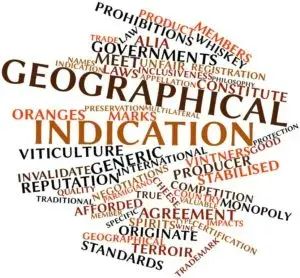Author: Shweta Tiwari, (LLB 3Years) student of Dr. DY Patil College of Law
Introduction
Geographical Indications (GIs) refer to signs used on products that have a specific geographical origin and possess qualities, reputation, or characteristics that are essentially attributable to that location. They are important because they protect products that are unique to a region and are often associated with traditional practices, craftsmanship, and a region’s cultural identity. GIs help consumers identify authentic products while ensuring that the producers from that region benefit from their unique goods.
In India, the concept of GIs is governed by the Geographical Indications of Goods (Registration and Protection) Act, 1999. The main objective of this act is to ensure that products linked to a particular region are not misused or imitated by unauthorized producers. For instance, products like Darjeeling Tea or Pashmina shawls are protected under the GI regime, and only those who produce these goods in the designated areas can use the GI tag.
Relation to Transfer of Property
The topic of Geographical Indications is relevant to the Transfer of Property because it involves the concept of ownership and rights. A GI essentially creates a collective right for the producers of a specific region, linking the quality of their goods to the geographical environment and traditional know-how. These rights are protected much like the rights over immovable property under the Transfer of Property Act, 1882, as they can be transferred, assigned, or inherited under specific conditions.
While property law deals with the transfer of tangible assets like land and buildings, GIs involve the legal ownership and transfer of intangible assets related to product origin and reputation. The legal provisions for the protection and transfer of these rights prevent unauthorised usage and help maintain the market value of these products.
Legal Provisions Related to Geographical Indications
Geographical Indications of Goods (Registration and Protection) Act, 1999:
Section 2(e) defines a GI as an indication that identifies goods as originating in a specific region where a given quality or reputation is attributable to its geographical origin.
Section 21 prohibits unauthorised persons from using a registered GI, ensuring that only registered producers from a specific region can use the indication.
Section 22 provides the protection of registered GIs from infringement by preventing the misuse of geographical names for products not originating from the registered region.
The Specific Relief Act, 1963: The enforcement of GIs can be pursued under this Act by seeking injunctions to stop unauthorized use of GIs, ensuring the protection of rights.
Intellectual Property Rights (IPR) Framework: GIs are a part of the broader IPR regime, which protects intangible property like patents, trademarks, and copyrights. GIs function similarly by protecting traditional knowledge and regional crafts under a collective ownership model.
Legal Significance of Geographical Indications
Protection Against Misuse: GIs help ensure that only producers in a specific region can market their products under the name of that region. For instance, only tea grown in Darjeeling can be sold as Darjeeling Tea. This protection helps consumers differentiate genuine products from imitations.
Economic Benefits: GIs add value to products because they carry a sense of exclusivity. Products like Mysore Silkand Kanchipuram Silk command higher prices due to their geographical branding, helping local producers to generate more income.
Cultural Preservation: GIs also help preserve traditional knowledge, skills, and methods of production that are passed down through generations. For example, Banarasi Sarees are made using traditional weaving methods unique to Varanasi.
Consumer Trust: GIs ensure that consumers know the origin of the products they are buying, giving them confidence in the authenticity and quality of the goods.
Examples of Geographical Indications in India
Darjeeling Tea (West Bengal): This was the first product to receive a GI tag in India. It is renowned for its unique aroma and flavor, which is directly linked to the climate and soil conditions of the Darjeeling region.
Pashmina Wool (Kashmir): Known for its softness and warmth, Pashmina wool products are highly valued across the world. Only wool produced in the Kashmir region can be marketed as “Pashmina.”
Alphonso Mango (Maharashtra): Known as the “king of mangoes,” Alphonso mangoes are famous for their rich flavor and aroma. The GI protection helps distinguish genuine Alphonso mangoes from imitations.
Nagpur Orange (Maharashtra): This GI product is known for its sweet-sour taste and is grown specifically in the Nagpur region.
Relevant Case Laws
1. Tea Board, India vs. ITC Ltd. (2011)
Facts: The Tea Board of India filed a case against ITC Ltd. for using the term “Darjeeling Lounge” for a section of a hotel. The Tea Board claimed that the use of the term “Darjeeling” was an infringement of their GI rights.
Issue: Whether the use of the name “Darjeeling” in the context of a hotel service infringed the GI protection for Darjeeling Tea.
Judgment: The court ruled that there was no infringement, as ITC was not selling tea or related products but only using the name to designate a lounge. The court clarified that GIs are product-specific and cannot extend beyond the goods they are registered for.
Significance: This case highlights the limited scope of GIs and how they are strictly tied to the product they represent.
2. Scotch Whisky Association vs. Pravara Sahakari Sakhar Karkhana Ltd. (2008)
Facts: The Scotch Whisky Association filed a case against an Indian company for labeling its whisky as “Scotch,” even though it was produced in India.
Issue: Whether the use of the term “Scotch” by an Indian company for a locally produced whisky infringed the GI protection for Scotch Whisky.
Judgment: The court ruled in favor of the Scotch Whisky Association, stating that the use of the term “Scotch” for a whisky produced outside Scotland was misleading and violated GI rules.
Significance: This case underscores the importance of GIs in protecting international products and preventing the misuse of regional names.
Conclusion
Geographical Indications are essential for safeguarding the identity and reputation of products tied to specific regions. They play a crucial role in promoting economic development, protecting cultural heritage, and providing consumers with assurance of authenticity. In India, the Geographical Indications of Goods Act, 1999 offers a comprehensive legal framework to ensure that only genuine products are marketed under registered GIs. By protecting both the producers and consumers, GIs serve as a vital tool in preventing the misuse of regional names and ensuring fair trade practices.
Legal cases such as Tea Board, India vs. ITC Ltd. and Scotch Whisky Association vs. Pravara Sahakari Sakhar Karkhana Ltd. illustrate the judicial approach to GI protection, ensuring that regional names are used correctly and lawfully. In essence, GIs not only protect products but also foster trust, quality, and fair competition in the marketplace.
FAQS
What is a Geographical Indication (GI)?
A Geographical Indication (GI) is a sign used on products that have a specific geographical origin and possess qualities, reputation, or characteristics attributable to that location. It typically indicates that a product is produced in a particular region using traditional methods, adding uniqueness and value to the goods.
Why are Geographical Indications important?
GIs help protect unique products tied to a region’s cultural heritage and natural environment. They prevent unauthorized use of geographical names, ensure fair competition, provide economic benefits to local producers, and maintain the authenticity and quality of products.
Which law governs Geographical Indications in India?
Goods (Registration and Protection) Act, 1999. This law provides a framework for registering GIs and protecting them from misuse and infringement.
Difference between a Trademark and a Geographical Indication?
A Trademark identifies goods or services from a particular company or individual, while a Geographical Indication links products to a specific geographical area. A trademark can be used by a single entity, but a GI is collectively used by all producers in the registered geographical region.
How do Geographical Indications benefit local producers?
GIs provide local producers with a competitive edge by highlighting the unique qualities of their products. This increases the market value of their goods, protects them from imitation, and helps in building a strong reputation for the region’s products.
Can Geographical Indications be transferred or sold?
GIs create a collective right that is linked to a geographical region and its producers. While they are not transferred in the traditional sense like property, the rights to use the GI tag can be regulated and licensed to authorized producers within the specified region.




